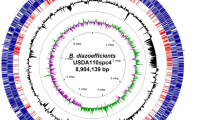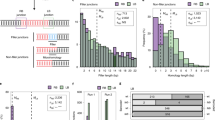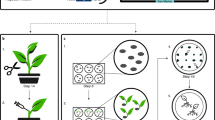Abstract
Brachypodium distachyon is a novel model system for structural and functional genomics studies of temperate grasses because of its biological and genetic attributes. Recently, the genome sequence of the community standard line Bd21 has been released and the availability of an efficient transformation system is critical for the discovery and validation of the function of Brachypodium genes. Here, we provide an improved procedure for the facile and efficient Agrobacterium-mediated transformation of line Bd21. The protocol relies on the transformation of compact embryogenic calli derived from immature embryos using visual and chemical screening of transformed tissues and plants. The combination of green fluorescent protein expression and hygromycin resistance enables early identification of transformation events and drastically reduces the quantity of tissue to be handled throughout the selection process. Approximately eight independent fully developed transgenic Bd21 plants can be produced from each immature embryo, enabling the generation of thousands of T-DNA lines. The process—from wild-type seeds to transgenic T1 seeds—takes ∼8 months to complete.
This is a preview of subscription content, access via your institution
Access options
Subscribe to this journal
Receive 12 print issues and online access
$259.00 per year
only $21.58 per issue
Buy this article
- Purchase on SpringerLink
- Instant access to full article PDF
Prices may be subject to local taxes which are calculated during checkout



Similar content being viewed by others
References
Vain, P. Global trends in plant transgenic science and technology (1973–2003). Trends Biotechnol. 24, 206–211 (2006).
Napoli, C., Lemieux, C. & Jorgensen, R. Introduction of a chimeric chalcone synthase gene into petunia results in reversible co-suppression of homologous genes in trans . Plant Cell 2, 279–289 (1990).
Hamilton, A.J. & Baulcombe, D.C. A species of small antisense RNA in posttranscriptional gene silencing in plants. Science 286, 950–952 (1999).
Vain, P. Thirty years of plant transformation technology development. Plant Biotechnol. J. 5, 221–229 (2007).
Vain, P. & Thole, V. Gene insertion patterns and sites. In Methods in Molecular Biology Transgenic Wheat, Barley and Oats: Production and Characterization Protocols (eds. Shewry P. & Jones H.D.) pp 203–226 (Humana Press, Totowa, New Jersey, U.S.A., 2008).
Hiei, Y., Ohta, S., Komari, T. & Kumashiro, T. Efficient transformation of rice (Oryza sativa L) mediated by Agrobacterium and sequence analysis of the boundaries of the T- DNA. Plant J. 6, 271–282 (1994).
Ishida, Y. et al. High efficiency transformation of maize (Zea mays L) mediated by Agrobacterium tumefaciens . Nat. Biotechnol. 14, 745–750 (1996).
Cheng, M. et al. Genetic transformation of wheat mediated by Agrobacterium tumefaciens . Plant Physiol. 115, 971–980 (1997).
Tingay, S. et al. Agrobacterium tumefaciens-mediated barley transformation. Plant J. 11, 1369–1376 (1997).
Zhao, Z.Y. et al. Agrobacterium-mediated sorghum transformation. Plant Mol. Biol. 44, 789–798 (2000).
James, C. Global status of commercialized biotech/GM crops: 2007. ISAAA Briefs 37 xvii, 143 (2007).
Draper, J. et al. Brachypodium distachyon. A new model system for functional genomics in grasses. Plant Physiol. 127, 1539–1555 (2001).
Garvin, D.F. et al. Development of genetic and genomic research resources for Brachypodium distachyon, a new model system for grass crop research. Crop Sci. 48, S69–S84 (2008).
Opanowicz, M., Vain, P., Draper, J., Parker, D. & Doonan, J.H. Brachypodium distachyon: making hay with a wild grass. Trends Plant Sci. 13, 172–177 (2008).
Griffiths, S. et al. Molecular characterization of Ph1 as a major chromosome pairing locus in polyploid wheat. Nature 439, 749–752 (2006).
Christiansen, P., Andersen, C.H., Didion, T., Folling, M. & Nielsen, K.K. A rapid and efficient transformation protocol for the grass Brachypodium distachyon . Plant Cell Rep. 23, 751–758 (2005).
Vogel, J.P., Garvin, D.F., Leong, O.M. & Hayden, D.M. Agrobacterium-mediated transformation and inbred line development in the model grass Brachypodium distachyon . Plant Cell Tissue Organ Cult. 84, 199–211 (2006).
Vogel, J. & Hill, T. High-efficiency Agrobacterium-mediated transformation of Brachypodium distachyon inbred line Bd21-3. Plant Cell Rep. 27, 471–478 (2008).
Vain, P. et al. Agrobacterium-mediated transformation of the temperate grass Brachypodium distachyon (genotype Bd21) for T-DNA insertional mutagenesis. Plant Biotechnol. J. 6, 236–245 (2008).
Pãcurar, D.I., Thordal-Christensen, H., Nielsen, K.K. & Lenk, I. A high-throughput Agrobacterium-mediated transformation system for the grass model species Brachypodium distachyon L. Transgenic Res. 17, 955–963 (2008).
Bablak, P., Draper, J., Davey, M.R. & Lynch, P.T. Plant regeneration and micropropagation of Brachypodium distachyon . Plant Cell Tissue Organ Cult. 42, 97–107 (1995).
Vain, P., Worland, B., Kohli, A., Snape, J.W. & Christou, P. The green fluorescent protein (GFP) as a vital screenable marker in rice transformation. Theor. Appl. Genet. 96, 164–169 (1998).
Murray, F., Brettell, R., Matthews, P., Bishop, D. & Jacobsen, J. Comparison of Agrobacterium-mediated transformation of four barley cultivars using the GFP and GUS reporter genes. Plant Cell Rep. 22, 397–402 (2004).
Shrawat, A.K. & Lorz, H. Agrobacterium-mediated transformation of cereals: a promising approach crossing barriers. Plant Biotechnol. J. 4, 575–603 (2006).
Murashige, T. & Skoog, F. A revised medium for rapid growth and bio-assays with tobacco tissue cultures. Physiol. Plant. 15, 473 (1962).
Gamborg, O.L., Miller, R.A. & Ojima, K. Nutrient requirements of suspension cultures of soybean root cells. Exp. Cell Res. 50, 151 (1968).
Garfinkel, D.J. & Nester, E.W. Agrobacterium-tumefaciens mutants affected in crown gall tumorigenesis and octopine catabolism. J. Bacteriol. 144, 732–743 (1980).
Acknowledgements
This work was supported by the UK Biotechnology and Biological Sciences Research Council (BBSRC) and through a Short-Term Marie Curie EST fellowship.
Author information
Authors and Affiliations
Corresponding author
Rights and permissions
About this article
Cite this article
Alves, S., Worland, B., Thole, V. et al. A protocol for Agrobacterium-mediated transformation of Brachypodium distachyon community standard line Bd21. Nat Protoc 4, 638–649 (2009). https://doi.org/10.1038/nprot.2009.30
Published:
Issue date:
DOI: https://doi.org/10.1038/nprot.2009.30
This article is cited by
-
Genome-wide identification of the plant homeodomain-finger family in rye and ScPHD5 functions in cold tolerance and flowering time
Plant Cell Reports (2024)
-
Phytochromes transmit photoperiod information via the evening complex in Brachypodium
Genome Biology (2023)
-
Fast-track transformation and genome editing in Brachypodium distachyon
Plant Methods (2023)
-
Studies on the callus induction and Agrobacterium-mediated transformation of Asia minor bluegrass (Polypogon fugax)
Journal of Plant Biochemistry and Biotechnology (2023)
-
Improving bread wheat yield through modulating an unselected AP2/ERF gene
Nature Plants (2022)



